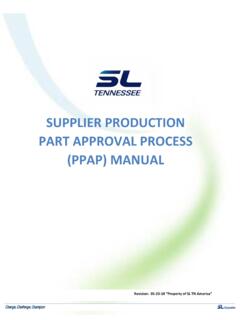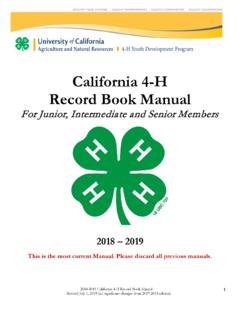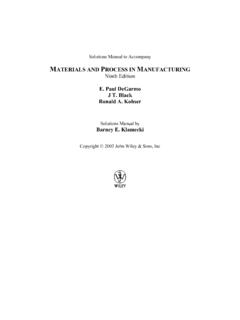Transcription of Supplier Production Part Approval Process (PPAP) Manual
1 Supplier Production PART Approval Process (PPAP) Manual Revision: 05-23-18 Property of SL TN America Supplier PPAP Manual Revision: 05-23-18 Page 1 TABLE OF CONTENTS Revision Page .. 2 Forward .. 3 Purpose .. 3 When is PPAP Submission Required? .. 3 Supplier Request for Engineering Approval (SREA) Instructions .. 4 Elements of a PPAP Submission .. 4 PPAP Submission Levels .. 5 PPAP Submission Method .. 6 Significant Production Run .. 6 PPAP Submission Status .. 6 Annual Validation .. 6 Special Characteristics .. 7 Key Product Characteristic (KPC) Definitions .. 7 Special Characteristic Approval Form (SCAF) .. 8 Key Control Characteristic Definition .. 8 Special Characteristic Controls .. 8 PPAP Training .. 10 Instructions for Completing a PPAP Submission .. 10 Part Submission Warrant (PSW) .. 10 Design Records .. 10 Approved Engineering Change Documentation .. 11 Customer Engineering Approvals.
2 11 Design FMEA .. 11 Process Flow Diagrams .. 11 Process FMEA .. 12 Severity Rankings .. 12 Occurrence Rankings .. 13 Detection Rankings .. 14 Production Control Plan .. 14 Measurement System Analysis Studies (MSA) .. 16 Dimensional Results .. 16 Single Cavity Mold .. 17 Multiple Cavity Molds .. 17 Material and Performance Test Results .. 17 Material Test Results .. 17 Performance Test Results .. 18 International Material Data System (IMDS) .. 18 IMDS Approval .. 18 IMDS Rejection .. 18 Initial Process Study 19 CpK .. 19 PpK .. 19 Qualified Laboratory Documentation .. 20 Appearance Approval .. 20 Sample Parts .. 20 Master Samples .. 21 Checking Aids .. 31 SL TN Specific Requirements .. 21 Tooling Loan Agreement .. 21 Packaging Form .. 22 Launch Inspection Program .. 22 Special Process Audits .. 23 Supplier Agreement and Sign off .. 24 Supplier PPAP Manual Revision: 05-23-18 Page 2 REVISION PAGE Revision Date Section Description of Change Reason for Change 10-15-2013 All New document.
3 Electronic Approval (ref. DCC Master Dbase) ICAR 664, 665 & 673 (Ford Q1 Assessment) 11-01-2013 Added when to us Cpk and Ppk index ICAR 1128 (Ford Q1 Assessment) Added ref. to Supplier PPAP Form Pack ICAR 1128 (Ford Q1 Assessment) All New Document. Supplier PPAP Forms Pack ICAR 1128 (Ford Q1 Assessment) 06-15-2015 Added Special Characteristic Approval Form (SCAF) ICAR 1076 (Internal VDA Audit) , Material Testing Form, Performance testing Form ICAR 1075 (Internal VDA Audit) Update Production Control Plan to include Measuring and monitoring Device and characteristic number requirement. ICAR 1079 (Internal VDA Audit) Updated checking Aids to identify gages ICAR 1075 (Internal VDA Audit) 03-15-2016 Clarification of KPC requirements during annual validation. ICAR 1570 (GM QSB + Audit) Added D/TLD, SC, CC HC and OS requirements. Clarification of Controls used for KPC and added section Special Characteristic Controls ICAR 1497 (Ford Q1 Assessment). ICAR 1494 (Ford Q1 Assessment) Added examples of processes to be included in the Process Flow ICAR 1494 (Ford Q1 Assessment) Clarification of PFMEA requirements ICAR 1579 and 1753 (GM PFMEA Process Audit) Clarification of Control Plan requirements ICAR 1494 (Ford Q1 Assessment) Clarification of Launch Inspection Requirements ICAR 1748 (GM Process Audit ) Added Supplier Agreement and Sign off To required Supplier sign off of requirements.
4 05-15-2016 Added Supplier Request to Remove Launch Inspection form to complete by the Supplier . ICAR 1748 (GM Process Audit ) and ICAR 1844 (GM Process Audit) 01-01-17 Added The number of distinct categories (ndc) the measurement Process can be divided into shall be greater than or equal to 5 . AIAG MSA 4th ed. requirement Removed: A Gage R&R template is included in Supplier PPAP Pack Forms Template is Long Gage Study, want to encourage use of ANOVA Method. Added: The preferred method for calculating Gauge R&R is by using the Analysis of Variance (ANOVA) method . Added: GR&R shall be reported as a percent of tolerance . Was implied but not specified. 06-20-2017 Fit/Function KPC s require a Cpk index of or greater or a Ppk index of or greater Typo 05-23-2018 Add Printed name field to signature section Easier to identify hard to read or Chinese/Korean signatures Supplier PPAP Manual Revision: 05-23-18 Page 3 Foreword The purpose of this document is to communicate SLTN s requirements with respect to the PPAP Process to those companies that supply materials and components to SLTN.
5 These requirements are fully compliant with the Automotive Industry Action Groups (AIAG) Production Part Approval Process (PPAP) standard revision 4 March, 2006. SLTN has specific requirements and additions to this standard that need to be fully understood before attempting to successfully submit a PPAP to SLTN for review and Approval . Purpose The purpose of the Production Part Approval Process (PPAP) is: To provide the evidence that all SLTN engineering design and specification requirements are properly understood and fulfilled by the Supplier . To demonstrate that the Supplier s manufacturing Process has the potential to produce product that consistently meets all requirements during an actual Production run at the quoted Production rate. When is PPAP Submission Required? A PPAP is required anytime a new part or a change to an existing part or Process is being planned. It is at the discretion of SLTN to determine when and if a PPAP submission will be required. In the event a PPAP submission is not requested, SLTN Supplier Quality reserves the right to request any of these documents at any time during the life of the product.
6 SLTN Supplier Quality reserves the right to request a PPAP submission for a variety of reasons including all of the following: New part or product New Supplier New Process or technology Changes to existing product Change to material or component New, additional or modified tools Upgrade of existing tools Tooling, Production , or equipment transferred to a different site Product when tooling has been inactive for 12 months Product or Process changes on the components of the product Change in test or inspection method Bulk material: New source of raw material Change in product appearance attributes Change of sub- Supplier or material source Supplier PPAP Manual Revision: 05-23-18 Page 4 If the Supplier has additional questions concerning the need for a PPAP Submission, they should contact their designated SLTN Supplier Quality Engineer (SQE). Supplier Request for Engineering Approval (SREA) Instructions Whenever the Supplier is planning a change that affects a part or the Process making that part, it is the Supplier s responsible to get Approval from SLTN prior to initiating that change.
7 To request Approval for the change, the Supplier should submit a Supplier Request for Engineering Approval (SREA). The SREA is used to initiate: Permeate print related change Temporary deviation from print Move of manufacturing to new facility Cost saving change Change of sub- Supplier A change of material composition Manufacturing Process change Packaging Change The SREA must be approved by SLTN prior to implementation. Failure to have an approved SREA may affect future business opportunities. SLTN assumes the Supplier will notify SLTN of any planned change(s) a minimum of 90 days prior to planned implementation (Reference. SLTN s Supplier Requirements Manual ). The additional requirements section on the form can be used to document any additional testing, performance data or engineering changes that may be required to make the proposed change successful. Elements of a PPAP Submission The SLTN PPAP submission requirements are compliant with the existing AIAG standard.
8 One or more of the following elements may be required depending upon the assigned submission level: 1. Part Submission Warrant (PSW) 2. Design Records & Ballooned Drawings 3. Approved Engineering Change Documents 4. Customer Engineering Approval 5. DFMEA 6. Process Flow Diagram 7. PFMEA 8. Control Plan 9. Measurement Systems Analysis (MSA) 10. Dimensional Results 11. Material, Performance Test Results 12. Initial Process Study (Cpk) Capability Studies 13. Qualified Laboratory Documentation 14. Appearance Approval 15. Sample Product Parts 16. Master Sample(s) 17. Checking Aids 18. SLTN - Specific Requirements Tooling Loan Agreement Packaging Form Supplier PPAP Manual Revision: 05-23-18 Page 5 Pre-Launch Control Plan Launch Inspection Report Specification Deviation Supplier PPAP Worksheet Unless otherwise noted, the Supplier should document their PPAP submission using SLTN s Supplier PPAP Forms (Pack) or AIAG compliant Core Tools Forms. MS Excel templates for Core Tools Forms are available from AIAG.
9 Submission Levels Submission levels define which elements are required for submission. The levels are used for different reasons and applications. The level to be submitted is determined by SLTN, and unless otherwise noted, always defaults to Level 3 which is a full PPAP submission. There are five submission levels listed below, and each is typically applied to the specific areas listed. Level 1: Warrant with Appearance Approval Report This level applies to Non-critical parts, non critical raw/bulk material or catalog/ commodity parts for electrical applications and re-certification of existing parts previously approved by SLTN at levels 3, 4 or 5. Also used for self-certification. Level 2: Warrant with product samples and limited supporting data This level applies to Critical Bulk products such as Plastic/Paint/Chemicals, critical fasteners, simple material changes, simple revision level only changes or simple print updates not affecting form-fit-function. This level can also be applied to low and medium risk parts within a product family Level 3: Warrant with product samples and complete supporting data This level applies to new parts on SLTN programs or changes effecting form-fit-function, reliability, or performance.
10 All products resourced to new Suppliers, serial Production parts, and existing high risk parts undergoing a part number change (default SLTN Submission Level) Level 4: Warrant and other requirements as defined by the customer This level are reserved for special applications only. Level 5: Warrant with product samples & complete supporting data reviewed @ Supplier s location All submissions must be in English. Immediate rejection will result if not submitted in English. Changes to existing parts will be handled on a case-by-case basis and submissions other than level 3 require prior Approval from SLTN s SQE. IMDS is required for any PPAP submission (ref. Element 11). The IMDS module must be submitted to, and approved by, SLTN prior to PPAP submission. The IMDS module number and revision level must be recorded on the PSW. Failure to submit an approved IMDS prior to PPAP will delay Approval of the PPAP package. The level required for the Supplier s PPAP submission is determined by SLTN.









